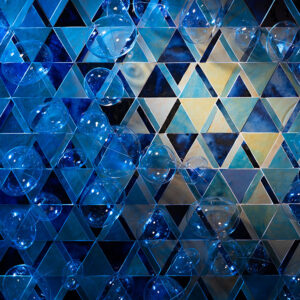 Harbor City, Calif.—Lunada Bay Tile introduced the Mistral collection, which was designed to reinterpret the heritage of Zellige tiles for the modern day. As one of the oldest tile-making traditions in the world, Zellige tiles have adorned mosques and palaces for centuries.
Harbor City, Calif.—Lunada Bay Tile introduced the Mistral collection, which was designed to reinterpret the heritage of Zellige tiles for the modern day. As one of the oldest tile-making traditions in the world, Zellige tiles have adorned mosques and palaces for centuries.
“Zellige is truly timeless in tile design,” said Feras Irikat, marketing and design director, Lunada Bay Tile. “These tiles are characterized by glazed, irregular surfaces and can be used to create stunning mosaic designs in captivating geometric patterns.”
Zellige is a style of mosaic tilework made from individually hand-chiseled tile pieces and is one of the oldest continually practiced tilemaking traditions in the world. Likely originating in the ninth century in modern day Tunisia, Zellige uses tiles of distinct colors that are fitted together to form various patterns based on tessellations or infinitely repeating forms.
The Lunada Bay Tile design team worked closely with tile makers in Fez, Morocco who employ time-honored methods that have been perfected and passed down over generations. Mistral tiles are made completely by hand in the same way authentic Zellige has been made for centuries. This artistic tradition encapsulates a genuine expression of handmade tiles that results in “imperfect” but beautifully unique tiles that vary one from the other in surface, edge and color.
“The new Mistral patterns are inspired by modern aesthetic from different decades and the traditional art of making Zellige tile,” Irikat said.
The mastery of Mistral Moroccan mosaics
Mistral took time honored Zellige designs and formed them into four patterns to reflect modern sensibilities. Bab, which means “gate or big door” in Arabic, is drawn from a traditional pattern but modernized with a curve at the top. It is also inspired by traditional marble and Byzantine-inspired design. The pattern represents a movement between two opposing pieces mirroring each other. Reverie is an artistic combination of several geometric shapes and incorporates mid-century modern design influences, mixing and matching shapes. Kilim is a triangle shape representative of the amulet protection motifs seen in Kilim rugs, but also inspired by Art Deco influences. Trapezium is a traditional Zellige pattern with an added sense of play in a mirrored trapezoid pattern.
The colors span from a gentle Sheer and All in White to a seafoam green Lotus; to Odyssey, a wavy midnight blue; Phantom, a dusky mix of greys, blacks and charcoal; and spicy Sumac, a complex hue reminiscent of ground dried berries and red earth, among others. These on-trend colors are meant to echo today’s aesthetics.
Bab, Kilim, Reverie and Trapezium have blends of different glaze colors for each colorway. On the other hand, the 3×4 Trapezoid Field and Small Bullnose come in single or solid glaze colors—the colors have variation, but are not blends of different colors.
The making of Mistral
The making of Mistral is a laborious, hand-made process, following the time-honored traditions of Zellige tile-making. Locally sourced clay is pressed by hand into tray-sized molds, then pounded and manipulated with wooden mallets after drying in the sun. After kiln-firing, each bisque tile is hand-dipped in glaze before it is kiln-fired again, then expertly hand-chiseled into its final shape and fitted together to create its intricate patterns. The transition from using olive pits and bits of wood to modern natural gas kilns is the only real change to the entire process of making Zellige. Everything else remains the same as it has been over the centuries.
The Zellige art form remains not only one of the hallmarks of Moroccan cultural and artistic identity but is also said to enjoy popularity in U.S. modern architecture and design.
“Today, Zellige still can be found in many areas in homes,” Irikat said. “These newly imagined Zellige tiles can be used here in backsplashes, of course, but also can be used artfully to create accent walls in living and dining rooms, or as a decorative frame for a doorway or on ceilings.”
